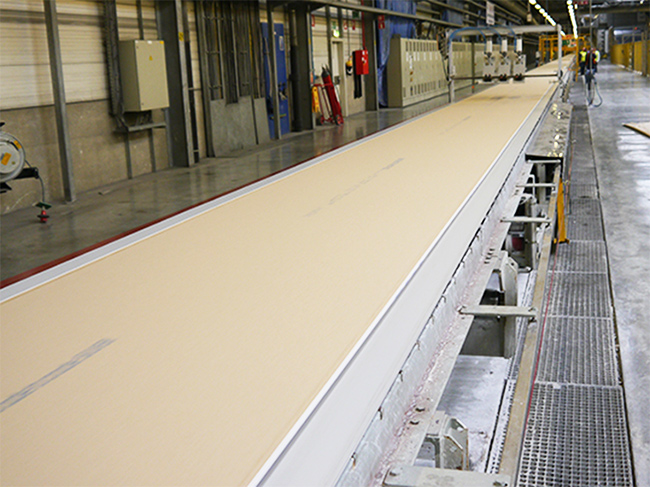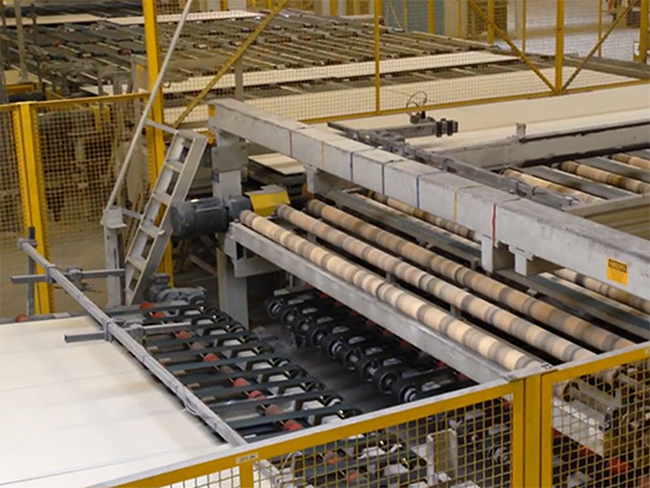Copyright © Wuxi Mingcheng Transmission Technology Co., Ltd. All Rights Reserved.
Google Analytics Technical Support:NSW
1. Forming Belt
The forming belt is the most sensitive but equally most important component in the entire production process. It both starts and lies at the heart of the production process. The wet gypsum mixture is formed and hardened on it as a flat endless sheet between two layers of heavyweight paper.
Technical Requirements of the belts
To manufacture high-quality plasterboard, the surface quality of the belt has to be superb, its thickness across its entire width, length and splice precise, it needs to track absolutely straight and have a low friction coefficient. These superior belts stand apart for their long service lives but consistently retain the above-mentioned characteristics at the same time. Should minor damage to the belt’s surface occur, it needs to be put it right quickly, easily and efficiently.

2. Taper Edge Belt
Taper edge belts form the edge shape of certain plasterboards so that these can subsequently be filled on construction sites. They are placed onto the forming belt on both edges of the panels. Taper edge belts are available in virtually all shapes.
Technical Requirements
The shape of taper edge belts should of course match the customer’s production portfolio. Depending on the panel type made, they need to be integrated into the process and removed again without requiring any extra tools. In this case, flexibility and speed have top priority.
The undersides of the taper edge belts should be as soft as possible so that they don’t damage the forming belt underneath. Even if they have long service lives, it’s imperative that taper edge belts maintain their dimensions and don’t elongate.

3. Roller Drive Belts
Board conveying is inconceivable without roller drive conveyors. At this step of the process, the roller drive belts have to be fast, reliable and efficient.
Technical Requirements
Here, it’s crucial that the drive component is reliable and maintenance-free in terms of material flow and board conveying despite the high speeds involved.

4. Transfer Belts
Transfer belts move panels, but can also be used in various processes such as cross conveying, board flippers, dryer in-feed and out-feed sections, stacking and warehousing. They usually run in parallel in a set.
Technical Requirements
Whether the plasterboards are conveyed horizontally or diagonally, the belt’s top face must be able to guarantee reliable, non-slip conveying, especially in the wet section in front of the dryer channel. The belts must be able to position the panels exactly without them slipping.

5. Stack Conveyor Belts
Heavy live rollers or plastic modular belt conveyors are primarily used for conveying piles of boards usually conveyed horizontally. Special heavy-duty belts with appropriate characteristics allowing them to operate in tough conditions are required.
Technical Requirements
In addition to positioning the pile precisely, the belts must be able to convey the boards reliably and so that they don’t slip. As heavy forklift trucks convey the piles elsewhere, the conveyors and the associated belts need to be extra hard-wearing.

MINSEN is a conveyor belt manufacturer. The company is located in Wuxi, located on the beautiful shore of Taihu Lake, east of Shanghai-Nanjing Expressway, north of Beijing-Shanghai High-speed Railway, only 10 minutes from Wuxi Airport.

The substrate belt belongs to the plane high-speed transmissionbelt. Usually, the substrate belt has a base layer of nylon in the middle, andthe surface is covered with rubber, cowhide and fiber cloth. It is divided intorubber nylon sheet base band and cowhide nylon sheet base band.

Product Name:timing belt Material:Pu, rubber Color:white, black Specification:customized Processing and customization:Yes. Application:mechanical manufacturing.

Product Name:timing belt Material:Pu, rubber Color:white, black Specification:customized Processing and customization:Yes. Application:mechanical manufacturing.